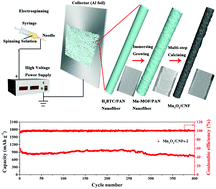Electrospinning-based construction of porous Mn3O4/CNFs as anodes for high-performance lithium-ion batteries†
Abstract
Transitional metal oxide nanoparticles and carbon composites have attracted tremendous research interest due to their potential as anode materials in next-generation lithium-ion batteries (LIBs). Herein, porous Mn3O4/carbon nanofibers (Mn3O4/CNFs) are designed and synthesized via electrospinning in combination with an in situ growth method followed by subsequent multi-step heat treatments. As an anode for LIBs, Mn3O4/CNFs-2 exhibits good cyclability with high reversible capacity. A reversible capacity of 754 mA h g−1 over 400 cycles at a current density of 0.1 A g−1 is achieved. The presence of CNFs can improve the conductivity of the electrode material and relieve the volume expansion of Mn3O4 during the process of Li+ insertion and extraction. Meanwhile, a small amount of N atom doping can enhance the reaction kinetics and Li+ pseudocapacitive behavior while providing reversible capacity and long cycling performance. Quantitative analysis shows that mixed diffusion-controlled and capactive behavior control mechanisms account for the Li+ storage, wherein the pseudocapacitive behavior can contribute to additional capacity.



 Please wait while we load your content...
Please wait while we load your content...